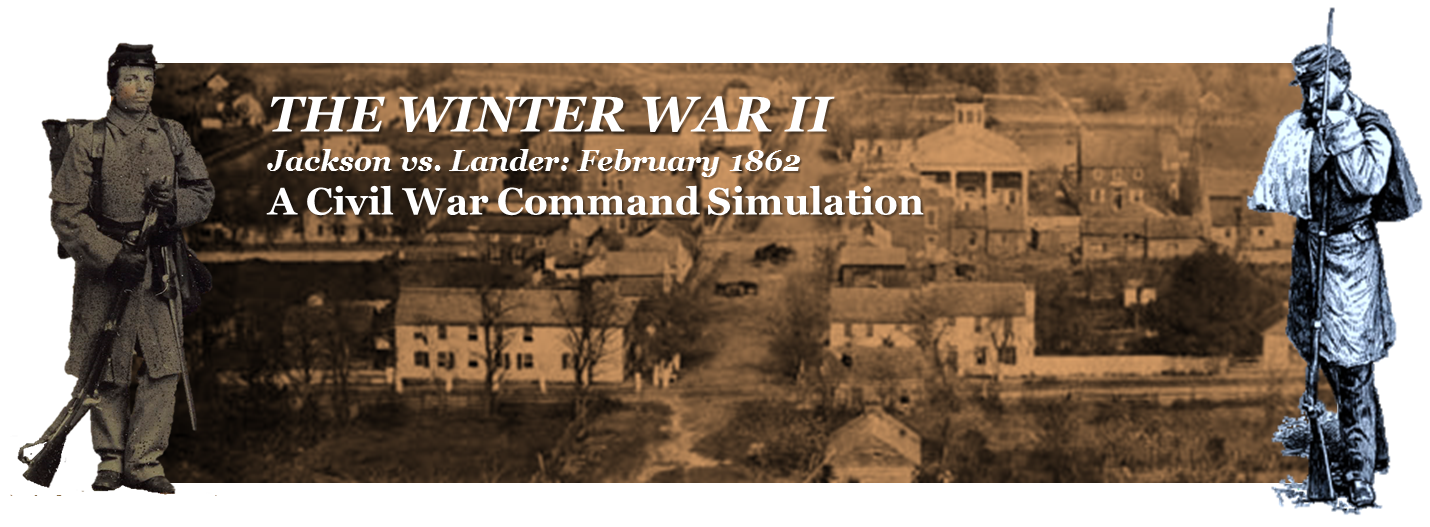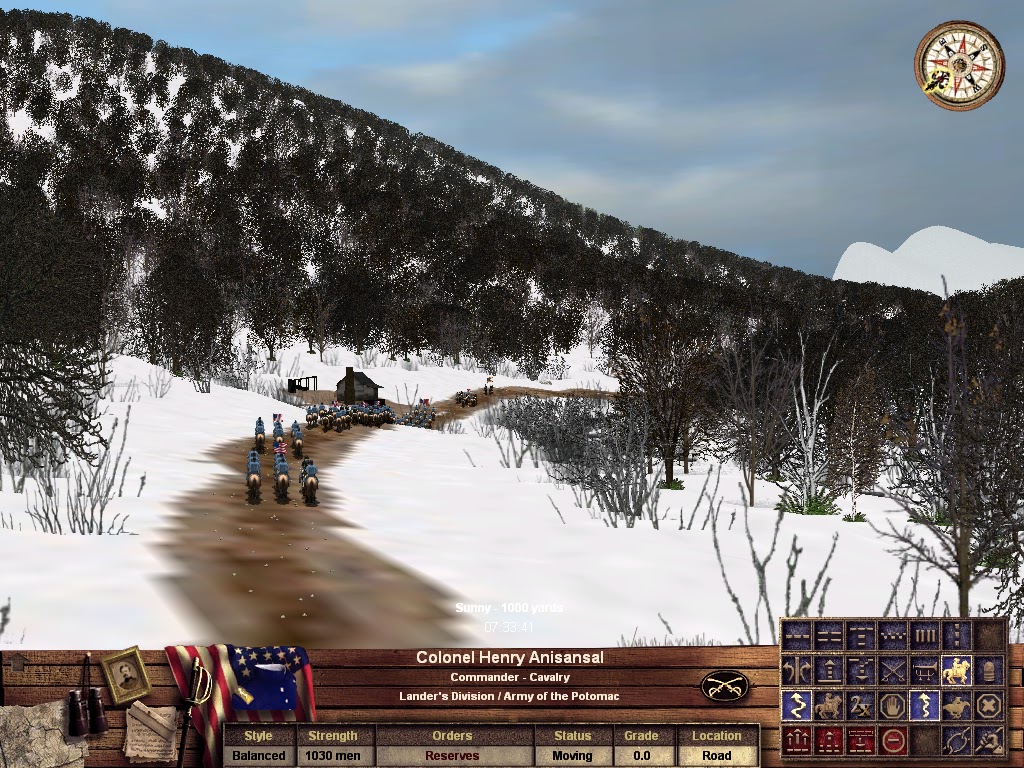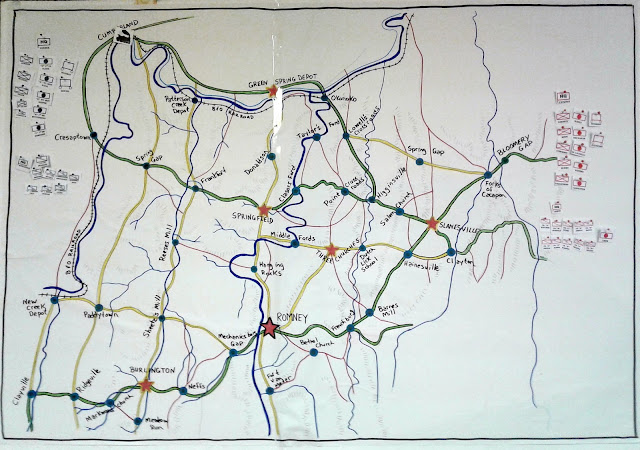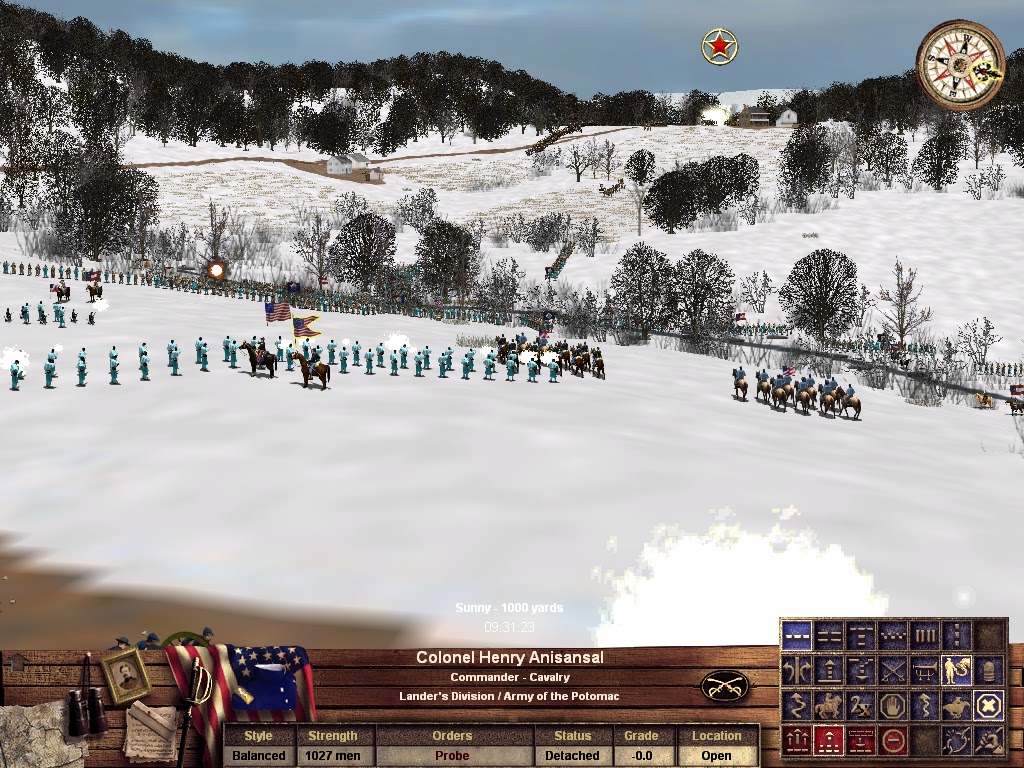Greg (Lander) has tested all of the maps that had been posted on the TC2M mods page. A few errors have been repaired, so they should all work fine. I am currently working on the Bloomery Gap map. It is the sight of Lander's last fight in February 1862. (He died in the beginning of March.)
Wheeling Intelligencer
February 16, 1862
From Paw Paw. – the First Virginia Regiment of Infantry, and the First Virginia Cavalry, are now in the vicinity of Paw Paw, on the Baltimore and Ohio Railroad, about thirty-five miles east of Cumberland. The boys of the First infantry marched around through the country, after leaving Patterson’s creek, for about ten days without any covering but the canopy of heaven, but fortunately they have all got their tents now and are doing well. Only a few members of the regiment are on the sick list, and its fighting force is as strong as ever it was.
On Sunday last, the day after the rout of the rebels at Bloomery, Gen. Lander sent a small party back to that place to see what the rebels were doing. The rebels had advanced to the vicinity of Bloomery Furnace, and as the reconnoitering party approached they were fired upon from ambush, and Capt. O’Brien, of Gen. Lander’s staff, received a shot in the breast, shattering his shoulder blade, and producing a wound from which he may not recover.
When the news of the taking of Fort Donelson reached Paw Paw, Gen. Lander was intensely delighted. To gratify and encourage his command, he got up on an ambulance and read the dispatch. It is said that there never was such shouting before and never will be again. The troops were all ordered out, notwithstanding the mud, and a regular jubilee was had.
Richmond Daily Dispatch
February 22, 1862
Western Virginia News
--The Superior at Bloomery--The Confederate loss, says the Winchester Virginia, in the attack on Bloomery, Hampshire county, was two wounded and thirty prisoners. The Yankees admit the loss of seven killed and fifteen wounded. The Confederate militia were surprised.--Colonel Scincludiver, of Berkeley, was in command. He escaped. The names of the prisoners taken by the Yankees are as follows:
Col R. F. Baldwin, Capt Lovett, Capt Wm Lodge, Capt Willis, Capt Beard, Lieut Col McCoole; David Carper, Isaac Carper and Chas Duval, of Capt Eddy's company; Chas W Bush, of Capt Bitzer's mounted militia; Jas Bell, of Capt Lodge's company; Thomas Steele, David Gratze, Adam Lawyer, Joseph Knight, Jos Ritter, and Buckner Massey, of Capt Pierce's company; Wm Jenkins, Geo Clark, and Wm Helland, of Capt Willis's company; Samuel McKown, of Capt Lodge's company; Lieut R. L Gray, of Capt Bear's Winchester company; and Jos McCartney, of Winchester.
Our troops, after the engagement, retired to Pughtown, in Frederick county, where they remain ? barring a few, who, with overdone prudence, retired to their homes, and are probably still there.
Official Records of the War of the Rebellion
Series 1, Volume 5, p. 405-407 Report of Brig. Gen. Frederick W. Lander, U. S. Army, of affair at Bloomery Gap, West Virginia.
PAW PAW, February 14, 1862?8 p. m.
The railroad was opened to Hancock this morning. Telegraph the same. Had an important forced reconnaissance last night completed to-day. Broke up the rebel nest at Bloomery Gap. Ran down and caught 17 commissioned officers, among them colonels, lieutenant-colonels, captains, &c. Will forward a descriptive list. Engaged them with 400 cavalry. Infantry not near enough to support, and enemy retiring. In all, 65 prisoners; killed 13. Lost 2 men and 6 horses at their first fire. Led the charge in person. It was a complete surprise. Colonel Carroll, commanding Fifth or Eighth Ohio, made a very daring and successful reconnaissance immediately afterwards to Unger's Store.
Major Frothingham is entitled to credit for building, under my direction, in 4 hours, in the dead of night, a complete bridge of wagons across the Great Cacapon, at an unfrequented road. Two columns of 2,000 men each marched 32, one column 43, miles since 4 p. m. yesterday, besides bridging the river. Papers taken and my own reconnaissance south prove the country clear and Jackson and Loring in Winchester. Made the move and occupied Bloomery Gap and Point?s Mill east on belief by deserters that General Carson?s brigade was there.
General Dunning has just arrived at New Creek from Moorefield, 40 miles south of Romney. Captured 225 beef cattle and broke up the guerrilla haunt there. Two of his men badly wounded. Killed several of the rebels.
As the work intrusted to me may be regarded done and the enemy out of this department, I most earnestly request to be relieved. If not relieved, must resign. My health is too much broken to do any severe work.
F. W. LANDER,
Brigadier-General.
Major-General McCLELLAN.
NOTE. General Williams can move over the river without risk. I respectfully commend Colonel Carroll to your notice. He is a most efficient and gallant officer. Lieut. H. G. Armstrong, acting assistant adjutant-general, and Fitz-James O'Brien joined me in a charge by which rebel officers were captured and confidence restored after cavalry had been checked.
Report of Col. J. Sencendiver, Virginia Militia, of affair at Bloomery Gap, West Virginia.
HDQRs. SIXTEENTH BRIGADE, VIRGINIA MILITIA,
Pughtown, February 17, 1862.
SIR: I have the honor to submit the following report of the engagement into which we were surprised on the morning of the 14th instant:
Our advanced pickets caine in about daylight and reported the enemy advancing upon us in large force. I gave orders to have the baggage packed immediately and the men prepared to meet the enemy and repulse him if possible. The Thirty-first Regiment, Colonel Baldwin, being quartered nearer the point from where the enemy was advancing than the balance of the command, rushed hurriedly to meet him. The Fifty-first, Major Wotring, and a portion of the Eighty-ninth, commanded by Major Davidson, hastened to his aid, but before they reached him the enemy's cavalry dashed through his ranks and inclosed him between them and their infantry and captured himself and nearly all his command. Majors Wotring and Davidson then took position on [a] hillside near the road and commenced a brisk fire on the cavalry, who advanced about 400 strong in full speed in pursuit of our wagons. While they were engaged with cavalry the infantry flanked them on the right and captured a number of their men and officers. As the cavalry neared our teams they were met by the Sixty-seventh Regiment and Company A, of the Eighty-ninth Regiment, who took a position on the hillside near the road and poured a heavy volley into them and checked them for a short time, but they again dashed forward, overtook our wagons, captured several of them, and turned them back towards Bloomery. At this juncture the Sixty-seventh and Company A, Eighty-ninth Regiment, advanced rapidly on either side of the road and commenced a brisk fire on them, and finally drove them back and recaptured the wagons. This was effected without the loss of a man. The enemy lost several men and horses killed at this point.
We then continued on after our wagons. The enemy followed us from this point about 2 miles, but at respectful distance. He picked up 1 or 2 stragglers and then retired.
We reached this place at sundown, and, as before reported, I sent yesterday morning a party with a flag of truce to bring off our dead and wounded. After a diligent search they did not find any killed and but two wounded, neither of them mortally.
They learned that the enemy was from 7,000 to 10,000 strong, commanded by General Lander. He returned the same evening towards Paw Paw, but threatened to return in two days. His loss was 11 killed and several wounded.
Our loss, I regret to say, is over 50 officers and privates missing.
Annexed is a list of officers captured: Col. B. F. Baldwin, Thirty-first Regiment; Capts. William Baird, acting assistant adjutant-general, and G. M. Stewart, Eighty-ninth Regiment; Capts. Thomas McIntyre, William Lodge, and Byron Lovett, Thirty-first Regiment; Capt. James Willis, Fifty-first Regiment; Lieut. Charles H. Brown, Thirty-first Regiment; First Lieut. William Wilson, Eighty-ninth Regiment; Lieuts. William A. Holland, Thomas Steele, R. L. Gray, A. L. White, H. R. Hottel, Isaac Rewner, and Joseph Seibert, Fifty-first Regiment.
All the officers and men engaged behaved themselves with commendable bravery, and I think they deserve great credit for having saved our stores and baggage.
Very respectfully reported.
J. SENCENDIVER,
Colonel, Commanding Brigade.
Major-General JACKSON.




































































